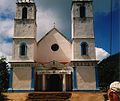Gambier Islands
 | |
| Geography | |
|---|---|
| Location | Pacific Ocean |
| Archipelago | Polynesia |
| Administration | |
France | |
| Demographics | |
| Population | 986 |
The Gambier Islands (Template:Lang-fr or [Archipel des Gambier] Error: {{Lang}}: text has italic markup (help)) are a small group of islands in French Polynesia, located at the southeast terminus of the Tuamotu archipelago. They are generally considered a separate island group from Tuamotu both because their culture and language (Mangarevan) are much more closely related to those of the Marquesas Islands, and because, while the Tuamotus comprise several chains of coral atolls, the Gambiers, especially the primary island, Mangareva, are of volcanic origin. Because of its proximity, the nearby atoll of Temoe (23°20′46″S 134°28′28″W / 23.34611°S 134.47444°W) is sometimes included among the Gambiers.
Administration

Together with the Tuamotus, the Gambier Islands form Îles Tuamotu-Gambier (French: (les) (Îles) Tuamotu-Gambier or officially la subdivision administrative des (Îles) Tuamotu-Gambier), one of the five primary administrative divisions (subdivisions administratives) of French Polynesia.
The Gambier Islands (Gambier), together with the islands in the eastern part of the Tuamotus (Anaa, Fangatau, Hao, Hikueru, Makemo, Napuka, Nukutavake, Puka-Puka, Reao, Tatakoto and Tureia), form Îles Gambier et Tuamotu Est, one of the 6 electoral districts (circonscriptions électorales) for the Assembly of French Polynesia (Assemblée de la Polynésie française).
The commune of Gambier is made up of the Gambier Islands (with uninhabited Temoe Atoll 40 km east of the main Gambier group), the uninhabited Acteon Group to the west (Matureivavao, Tenararo, Tenarunga, Vahanga), and the atolls of Marutea Sud, Maria Est and Morane. This group of islands and atolls covers an area of 35 km².
Although these archipelagos are administered as a single municipality (commune), the main village is Rikitea, on the largest island of Mangareva.
Geography

Mangareva's enclosing coral reef is broken by only three passages to the open sea. Besides Mangareva, the other notable islands of the group are Akamaru (23°10′52″S 134°54′56″W / 23.18111°S 134.91556°W), Angakauitai, Aukena (23°07′42″S 134°54′01″W / 23.12833°S 134.90028°W), Kamaka, Kouaku, Makapu, Makaroa, Manui, Mekiro and Taravai (23°08′12″S 135°01′33″W / 23.13667°S 135.02583°W). These are, like Mangareva, volcanic in origin. A number of others are actually coral islands, including Kauku, Papuri, Puaumu, Totengengie and the Tokorua group.
The islands are located at 23°09′S 134°58′W / 23.150°S 134.967°W., and are approximately 31 km² (12 mi²) in area. The total population in 2006 was 1,103 The primary town is Rikitea, located on Mangareva. The highest point in the Gambiers is Mt. Duff, on Mangareva, rising to 441 m along the island's south coast.
History
Gambier | |
|---|---|
A ship from Gambier. | |
 The Gambier Islands form the easternmost part of French Polynesia | |
| Country | France |
| Overseas collectivity | French Polynesia |
| Subdivision | Îles Tuamotu-Gambier |
| Government | |
| • Mayor (2008–2014) | Monique Labbeyi-Richeton |
| Area 1 | 46 km2 (18 sq mi) |
| Population (2007) | 1,337 |
| • Density | 29/km2 (75/sq mi) |
| INSEE/Postal code | 98719 /98755 |
| Elevation | 0–441 m (0–1,447 ft) |
| 1 French Land Register data, which excludes lakes, ponds, glaciers > 1 km2 (0.386 sq mi or 247 acres) and river estuaries. | |
There was a time (approximately the tenth to the fifteenth centuries) when the Gambiers hosted a population of several thousand people and traded with other island groups including the Marquesas, the Society Islands and Pitcairn Islands. However, excessive logging by the islanders resulted in almost complete deforestation on Mangareva, with disastrous results for the islands' environment and economy. The folklore of the islands records a slide into civil war and even cannibalism as trade links with the outside world broke down, and archaeological studies have confirmed this tragic story. Today, the islands can support a population of only a few hundred.
In 1834, the Belgian Jesuit priests Honoré Laval and François Caret founded a Roman Catholic mission in the Gambiers. After their success here, they moved to Tahiti in 1836.
Effects of French nuclear testing on the Gambiers
The Gambiers served as a logistical staging base for French nuclear testing activity in Mururoa. During this time, the French military dragged a chain through some of the coral reef beds to cut a wider and deeper channel for deep draft vessels. Higher rate of intoxications by ciguatera were subsequently recorded[1].
French military vessels visited the area (as of 1993) every six months collecting specimens of water, food, human hair and other material, as well as taking detailed accounts of births, deaths and other demographic events, presumably for on-going research into the effects of the nuclear testing. [citation needed].
References
- ^ "French accused of Pacific nuclear cover-up". The Guardian. Retrieved 2008-05-12.
- Jared Diamond, Collapse: How Societies Choose to Fail or Succeed (2005), Ch. 3
External links
- Atoll list (in French)
- Death of a People. A look at the decline of Mangareva and the missionary influence on the people of the Gambiers.


